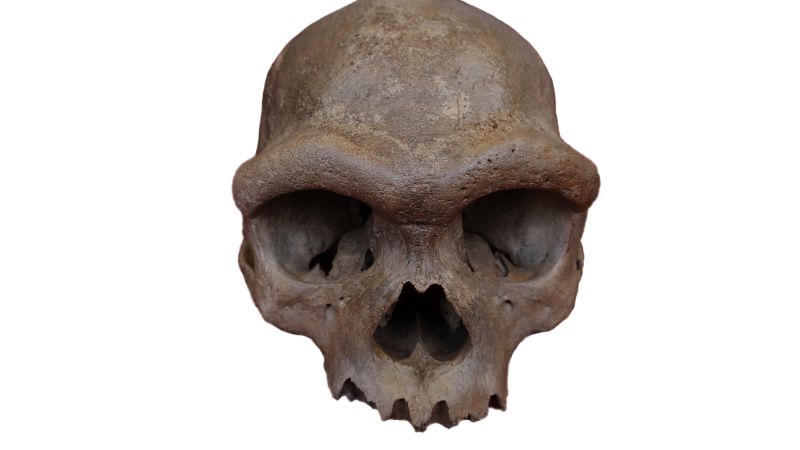The discovery of an unusual skull from a well located in northeastern China has sparked considerable interest among scientists, especially since it did not align with any previously identified prehistoric human species. This fossil, affectionately dubbed “Dragon Man,” has now yielded promising genetic insights that may help clarify its place in the evolutionary narrative, acting as a potential key to unlocking further mysteries surrounding early human species.
After several unsuccessful attempts, researchers succeeded in extracting genetic material from the fossilized cranium, which has been associated with an elusive group of early humans known as Denisovans. This new evidence could revolutionize our understanding of Denisovans, a group whose existence was first uncovered through the analysis of ancient DNA retrieved from a pinkie bone found in the Denisova Cave in Russia’s Altai Mountains in 2010. Up to this point, only a few fragmented Denisovan remains had been identified, leaving scientists with limited insights into their physical characteristics and overall classification.
Skulls, particularly those with distinct features such as bumps and ridges, are crucial for paleoanthropologists attempting to understand the anatomies of extinct hominin species. The recent findings suggest that the Dragon Man skull might bring us closer to conceptualizing what Denisovans actually looked like. Lead researcher Qiaomei Fu, a professor at the Institute of Paleontology and Paleoanthropology affiliated with the Chinese Academy of Sciences, expressed excitement about the discovery. She noted, “I really feel that we have cleared up some of the mystery surrounding this population. After 15 years, we know the first Denisovan skull,” highlighting the enduring intrigue of these ancient humans.
The initial discovery of Denisovans was a significant moment in anthropology, as it illuminated the fact that Homo sapiens were not the only human species coexisting during certain epochs of history. This revelation has contributed to increasingly complex discussions regarding human ancestry, particularly since modern humans have shown evidence of interbreeding with both Denisovans and Neanderthals. With most contemporary humans carrying traces of DNA from these ancient encounters, the complete picture of our evolutionary path remains tantalizingly incomplete, underscoring the importance of these findings.
The Dragon Man skull was ingeniously uncovered by a laborer in Harbin, China, back in 1933. During Japanese occupation, the laborer discovered it while constructing a bridge over the Songhua River and decided to preserve it by hiding it at the bottom of a well. Unfortunately, the skull lay in obscurity for decades until the man’s family uncovered its existence before his death, eventually donating it to Hebei GEO University. Initial examinations established the age of the skull at approximately 146,000 years, prompting researchers to propose a new species name, Homo longi, reflecting the geographical area of its discovery.
Determining this skull’s exact genetic lineage posed formidable challenges. Researchers faced difficulties in extracting viable DNA from the fossil due to its antiquity and preservation conditions. Through persistent efforts, Fu and her team retrieved mitochondrial DNA, which, although less comprehensive than nuclear DNA, nonetheless established a genetic connection to Denisovans.
Additionally, they discovered protein fragments that corroborated the skeletal evidence pointing to a Denisovan affiliation. Combined, these findings reinforce the notion that the Dragon Man skull may represent an integral piece of the Denisovan puzzle.
As debates continue regarding whether the skull should be officially classified under the new species name Homo longi or retain the historical moniker of Denisovan, the implications of this research remain profound. Experts suggest this discovery might provide a clearer picture of the biology and morphology of Denisovans while fostering a better understanding of their interactions with early Homo sapiens.
While the insights gained from this research are valuable, they also emphasize the complexity and ongoing mystery surrounding Denisovans. According to Ryan McRae, a paleoanthropologist at the Smithsonian National Museum of Natural History, the skull holds the potential to reshape our perspective on Denisovan ancestry, physical characteristics, and their place within the broader human family tree.
In conclusion, the exploration of the Dragon Man skull offers unparalleled insights into a once-enigmatic group of ancient hominins. The evolving narrative surrounding Denisovans enhances our understanding of human evolution and emphasizes the importance of continued research into these primordial relatives, whose story is intricately woven into the fabric of humanity’s past. As scientists work to further unravel these connections, the face of our prehistoric cousins may finally become clearer, bringing us closer to understanding the intricate web of human ancestry.












